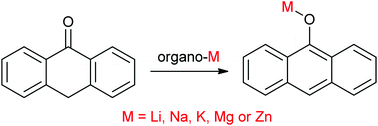Five novel neutral homometallic complexes which contain the anthracen-9-olate anion have been prepared and characterised by treating anthrone with an organometallic base to induce aromatisation. Three of these complexes [(donor)·M(OC14H9)]2 (2–4) are dimeric and contain sodium, lithium and potassium respectively. For 2 and 3 the donor is N,N,N′,N′-tetramethylethylenediamine (TMEDA) whilst for 4 it is N,N,N′,N′′,N′′-pentamethyldiethylenetriamine (PMDETA). When bimetallic reagents such as [(TMEDA)·Na(μ-tBu)(μ-TMP)Zn(tBu)] are employed, only the alkali-metal-containing species is isolated (e.g., 2 in this case). Providing a contrast, complexes 5 [(TMEDA)·Mg(OC14H9)nBu] and 6 [(TMEDA)·Zn(OC14H9)Et] are monomeric. The alkali metal complexes were prepared by reacting anthrone with one molar equivalent of either n-butylsodium, n-butyllithium or (trimethylsilyl)methylpotassium in the presence of the required donor solvent. For 5 and 6, equimolar quantities of di-n-butylmagnesium and diethylzinc, respectively, were reacted with anthrone in the presence of TMEDA. The solid-state structures and the arene solution structures of 2–6 have been determined by X-ray crystallography and NMR spectroscopy respectively.

